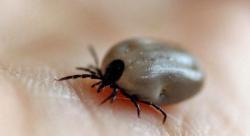
Lyme disease has been in the press recently with famous cases such as Avril Lavigne, documentaries on CBC, and increased public awareness. Lyme is caused by the spirochete, Borrelia that can infect every system of the body. It is named after the town of Lyme, Connecticut where a syndrome of tick bite, rash and arthritis was discovered to be caused by ticks carrying Borrelia. Lyme is not a new disease though – Borrelia was found in tissues of the recently discovered iceman Utzi, from five thousand years ago. Amber resin has been found with embedded ticks, carrying Borrelia from the Paleozoic era. In fact, Borrelia spirochetes were around before man!
Ticks are on the move and they come out as soon as the temperature is above 7 degrees Celsius. Ticks are referred to as the “dirty needle” of nature as they can carry numerous infectious diseases. The most well known is Lyme disease. Once a tick bites, it injects Borrelia from its saliva into the host’s bloodstream. Some studies have shown transmission in less than 24 hours. If a Lyme-infected tick bites a dog, they have a 5% risk of developing Lyme disease, whereas if a human is bitten the risk increases to 95%.
We want to prevent tick bites and transmission in our pets and help to lower risk to ourselves. We have started to vaccinate dogs at risk for Borrelia, and now include it in our core vaccinations during annual exams. Keep in mind that is not protection for all tick diseases, such as Ehrlichia, Anaplasma, Babesia and Bartonella — which is why we recommend yearly testing for tick-borne diseases. At our clinic we use a test that detects not only these tick-borne disease, but also Heartworm, transmitted by mosquitoes.
Tick prevention is very important – there are products labeled to aid in prevention which are 80% effective or stronger preventives that are >90%. Some products, such as organophosphate pesticides, repel ticks, but the tick can still bite again. These have a greater risk of toxicity (especially to cats) and they tend to lose effectiveness after two weeks; therefore we do not recommend their use.
Instead we recommend pharmaceutical products sold by prescription, which are not pesticide based. Revolution is a safe preventive for heartworm, fleas and ticks; and Nexgard and Bravecto are stronger tick preventives. If your dog has had ticks or is regularly on the trails or long grass you should consider one of these more robust preventives.
It is important to diagnose Lyme and tick diseases in the early stages for successful treatment. We recommend testing each spring – it can be done along with heartworm testing. Between 2013 and 2014 the number of positive Lyme cases through 4Dx heartworm testing in Ontario doubled. Heartworm has also increased by 34% in the past year in Ontario.
Studies in Ontario have found Lyme endemic in Rouge Valley, Ottawa Valley and Kingston area with cases throughout Ontario. Studies along the US border estimate that 200 million deer ticks are transmitted to Ontario by bird migration.
For tick protection we recommend preventive treatment from April to October. If your pet is an avid hiker, in the long grass or in the wilderness we also recommend Lyme vaccination.
